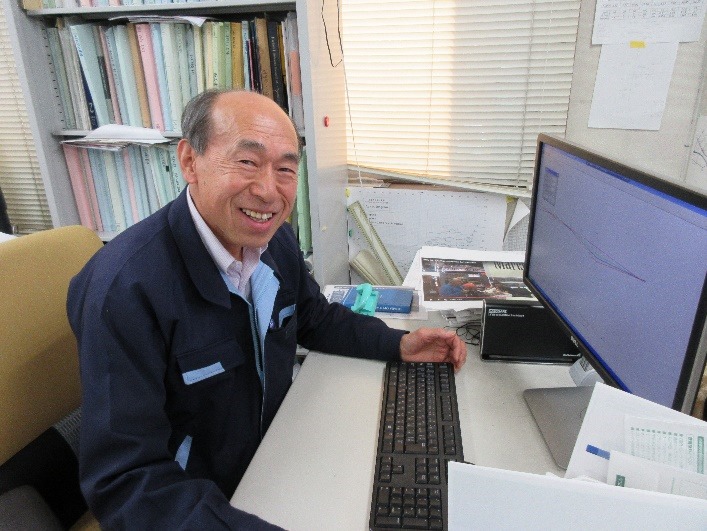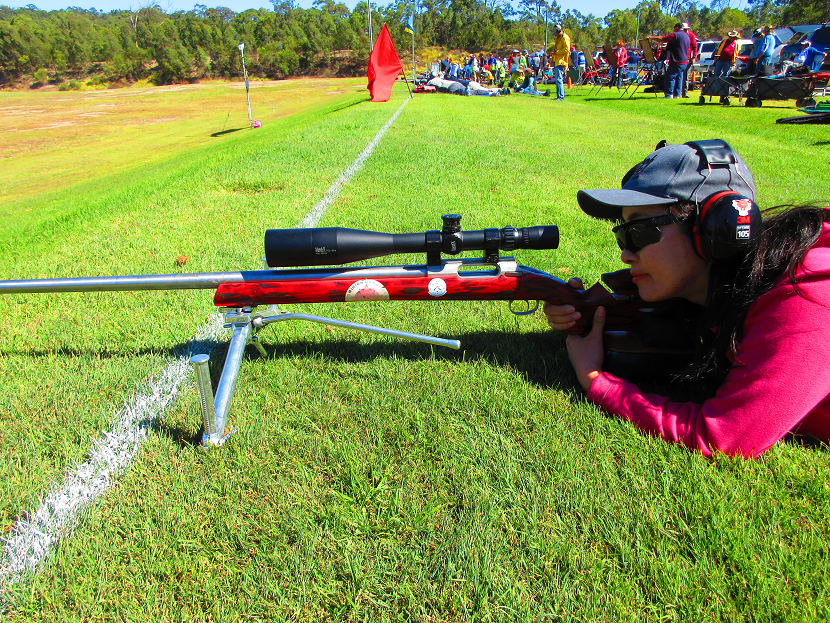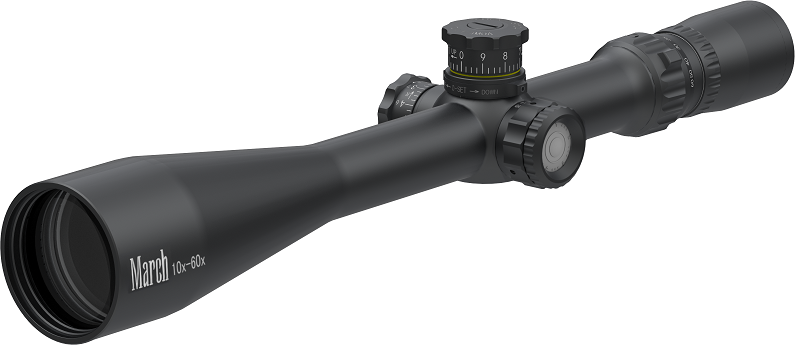Column Category
What is so special about High Master March Rifle Scope? Efforts improving the Resolving Power by 8.7 %
Posted 08/14/2019
Behind-the-scene story of the development of March-X High Master 10x-60x56mm Rifle Scope.
DEON-manufacturer of March Scopes made efforts to improve the resolving power by 8.7 % (comparison between
March 10x-60x52mm and March-X High Master 10x-60x56mm) in order to make more wins at shooting competitions.
Today we’d like to share the improved quality by explaining the performance difference between March 10x-60x52mm and
March-X High Master 10x-60x56mm as an example (in section 1 below) and the reason why we decided to develop
March-X High Master 10x-60x56mm (in section 2 below).
The Answerer
The Lens Specialist – Director Yasutoshi Nishikubo
Nishikubo is a Director and also one of the founders of DEON- manufacturer of March Scopes.

He designs the lenses for all March Scopes and also conducts the final tests. When he was young, he was fascinated by telescopes and he naturally chose his career in optical devices.
He worked at a company manufacturing OEM optical products for more than 30 years. At that company, he designed lenses for world’s top class rifle scope companies.
He is the world’s Top Lens Designer who is passionate about designing and accomplishing many world’s first lens design.
“In order to achieve more victories for March Owners, I want to be particular about how to improve the resolution by increasing the resolving power even for a small amount.”
The Questioner
Mari Morita (this article is written by Mari)

She previously worked for an advertisement company and joined DEON 8 months ago.
She shoots Air rifle & Rimfire rifle (.22 Long Rifle cartridge) under ISSF rule.
She also shoots 308 Winchester with her Remington M700.
She just recently participated in the F class competition held in Australia (August 5th – 10th, 2019) and had so much fun.
Thank you Australia for welcoming the Japanese team.
“By explaining the difference of March-X High Master 10x-60x56mm and March 10x-60x52mm, we would like you to feel our continuous efforts in trying to improve the resolution for even just a small amount”
(1) Improved quality
Mari : What is the performance difference between 10x-60x52mm and the evolved model High Master 10-60x56mm ?
Nishikubo: First of all please see the graph below.
I’d like to explain the changes made from 10x-60x52mm to High Master 10x-60x56mm.
10x-60x52mm

High Master 10x-60x56mm

|
|
10x-60x52mm |
High Master 10x-60x56mm |
|
① Effective diameter of the objective lens (mm) |
52 |
56 |
|
② Diameter of the body tube (mm) |
30 |
34 |
|
③ Overall length (mm) |
420 |
413 |
|
④ Weight(g) |
730 |
930 |
|
⑤ Types of lens |
ED lens |
Super ED lens |
|
⑥ Number of (super) ED lens |
1 |
2 |
|
⑦ Resolving power(Actual measurement value) |
2.5 |
2.3 (8.7%UP) |
① Effective diameter of the objective lens (lens facing the object)
The effective diameter of the objective lens has been enlarged from 52mm to 56mm.
The amount of light taking in has been increased and enhance the resolution.
② Diameter of the body tube
Body tube is the thinnest part where the turrets are set.
As we made it thicker from 30mm to 34mm, strength has been improved.
Also as there are more space inside the scope, we can elaborate on how to assemble lenses.
Please make sure that you use a mount ring for 34mm.
③ Overall length
As we developed new lens system, overall length is shorter by 7mm.
④ Weight
Since the body tube is thicker and we have more lenses assembled, total weight is heavier by 200g.
If the competition is strict with weight, you may want to avoid 200g increased weight.
⑤ Type of lens
ED lens is called special low-dispersion lens or Extraordinary low Dispersion lens.
ED lens uses material that color’s dispersion change is very small compared to a normal optical glass.
When used properly, we can gain an image with chromatic aberration next to nothing.
Especially at high magnification, ED lens is effective.
Super ED lens is an improved ED lens having an optical characteristic similar to fluorite.
Fluorite has the property of extraordinary dispersion.
By adopting Super ED lens, we can suppress chromatic aberration even more and realize a sharp image with greater contrast.
⑥ Number of ED lens
For 10x-60x52mm there is 1 ED lens, whereas for High Master 10-60x56mm there are 2 Super ED lenses.
Since there are 2 Super ED lenses having the similar optical characteristic similar to fluorite in High Master 10-60x56mm,
we think it is good value.
⑦ Resolving power
Please see section (2) for further explanation.
Price
Price is determined by the model, type of reticle and with or without illumination.
(Price may differ from what is stated here according to the material cost in the future)
Let’s compare the 10x-60x52mm High Master 10x-60x56mm under the same condition ;
same reticle (MTR-1・2・3・4・FT, with 0-set function, with illumination.
10x-60x52mm costs $3,150.00 (This is the MSRP in North America at August 2019. Please check the price at your nearest dealer.)
High Master 10x-60x56mm costs US$3,530.00 which is only $380.00 more expensive than 10x-60x52mm.
Considering the 56mm diameter of the objective lens, 34mm body tube and 2 Super ED lenses assembled in High Master 10x-60x56mm
this may be good value but for some competitions High Master’s features may be excessive.
If you are interested in other reticles or without illumination , please refer to our website.
Click here to see All the Scopes
Among customers who was using 10x-60x52mm previously and currently using High Master 10x-60x56mm, there are those who say
they can no longer go back to 10x-60x52mm. Because the Super ED lenses suppress the chromatic aberration even at long distances,
they have better visibility enabling them to see clearer even the mirage.
Our expert Japanese craftsmen poured their heart and soul into this development of High Master 10x-60x56mm.
We hope that you take High Master 10x-60x56mm in your hands and check the clear visibility.
All the High Master model scopes have 2 Super ED lenses with a new lens system.
Other than the March-X “High Master” 10x-60x56mm, we also have
March “High Master” 40x-60x52mm EP zoom
(2) The reason for development
Mari : 10x-60x52mm scope already has a superb resolution. Why did you think that you needed to develop an improved model?
Nishikubo: March-X High Master 10x-60x56mm scope was developed as an improved model of March 10x-60x52mm scope in 2017.
Please bear with my long explanation.
There is an indicator called “resolving power” to show how much you can see the details.
The smaller the resolving power is, the more you can see the details.
Theoretically, resolving power is determined by the size of the objective lens.
That means that the larger the diameter of the objective lens is, the smaller the value of the resolving power gets and consequently you are able to see smaller things.

Source of reference : https://www.nao.ac.jp/news/science/2019/20190410-eht.html
In April 2019, international cooperation project succeeded in proving the existence of the large Blackhole and its shadow by images taken by 8 radiotelescopes combined. Synchronizing the 8 radiotelescopes and utilizing earth’s rotation, the international cooperation project was able to make an imaginary earth size telescope with overwhelming resolution and photographic sensitivity. This means that because the objective lens was tremendously large being the size of an earth (hypothetically), the value of the resolving power became extremely small. They were able to gain an incredibly high resolution, 20 mu arc second, which is equivalent to 3 million times of people’s eyesight. As a result, they succeeded in taking a picture of the Blackhole which was considered impossible for a long time.
Resolving power of the lens is generally defined by Dawes’s empirical formula :
[Resolving power = 115.8 second /(devided by) diameter of the objective lens]
I mentioned that the resolving power of the (imaginary) earth size lens is 20 mu arc second but you can calculate the angle as below.
Unit for angles
1 rotation = 360 degrees
1 arc minute = 1/60 degree
1 arc second = 1/60 arc minute = 1/3600 degree
1 milliarcsecond = 1/1000 arc second
1 mu(μ) arc second = 1/1million arc second
Eyesight 1 = the ability to perceive 1 arc minute (equivalent to perceive 1mm object at 3m ahead)
The resolving power of the earth’s size lens is 20 mu arc second = 1/20million arc second.
If you convert this to eyesight it would mean that you are able to perceive 1mm object at 9000km ahead.
Now let’s calculate the resolving power of 2 March rifles scopes using Dawes’s empirical formula.
March 10x-60x52mm scope : resolving power of 52mm objective lens is 2.227 arc second
March 10x-60x52mm scope : resolving power of 56mm objective lens is 2.068 arc second
When we take 2.227 arc second (resolving power of 52mm objective lens)for 100,
2.068 arc second(resolving power of 56mm objective lens) will be 107.7.
This means that there is an improvement by 7.7% in resolving power.
The reason why we enlarged the size of the objective lens from 52mm to 56mm and developed High Master 10x-60x56mm is because of this “increase of resolving power by 7.7% ”We make continuous efforts so that the shooters can win at competitions, so that they can score 1 point more.
However this is a theoretical value and it is difficult to actualize to the exact value.
There is tolerance when manufacturing metallic material for lens.
Even though we get the precise measurements and make all the metallic materials according to calculation, metallic materials will expand and shrink affected by the temprature.
It is very difficult to align all the centers of the lens when combining them together.
Special telescopes such as astronomical telescopes are developed spending large sums so that they will be close to the calculated value as much as possible.
However for rifle scopes, lens are tightly fastened in order to tolerate the strong recoil of rifle scopes.
Therefore lens will slightly be contorted.
Also since we use many lens, we elaborate the quality by synthesizing design, precision of the components and assembly technique.
Values shown in the performance list is the actual value measured under various conditions.
Also upon comparing the actual measured value in the performance list (not the calculated value),
when we take 2.5 arc second (resolving power of 52mm objective lens)for 100,
2.3 arc second(resolving power of 56mm objective lens) will be 108.7.
This means that there is an improvement by 8.7% in resolving power which is 1.0% more than the calculated value.
So Mari now you know the reason why we keep trying to improve the lens system even for a slightest amount.
It’s because we want to be particular for even 1 point and commit to March Owner’s victories.
